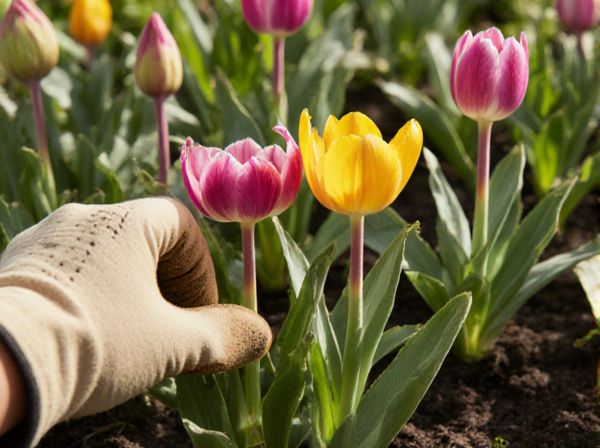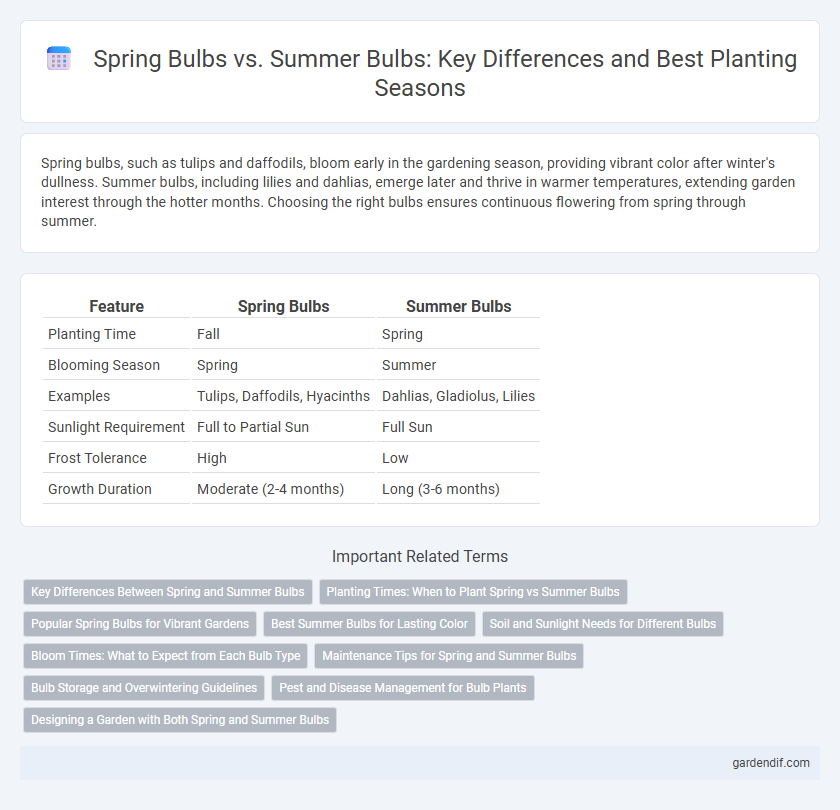
Spring bulbs vs Summer bulbs Illustration
Spring bulbs, such as tulips and daffodils, bloom early in the gardening season, providing vibrant color after winter's dullness. Summer bulbs, including lilies and dahlias, emerge later and thrive in warmer temperatures, extending garden interest through the hotter months. Choosing the right bulbs ensures continuous flowering from spring through summer.
Table of Comparison
| Feature | Spring Bulbs | Summer Bulbs |
|---|---|---|
| Planting Time | Fall | Spring |
| Blooming Season | Spring | Summer |
| Examples | Tulips, Daffodils, Hyacinths | Dahlias, Gladiolus, Lilies |
| Sunlight Requirement | Full to Partial Sun | Full Sun |
| Frost Tolerance | High | Low |
| Growth Duration | Moderate (2-4 months) | Long (3-6 months) |
Key Differences Between Spring and Summer Bulbs
Spring bulbs like tulips, daffodils, and crocuses generally require a cold dormancy period to bloom early in the season, while summer bulbs such as lilies, dahlias, and gladiolus thrive in warmer soil and bloom later, often requiring full sun. Spring bulbs are planted in the fall and emerge as soon as temperatures rise, contrasting with summer bulbs that are typically planted in spring or early summer for blooms throughout warmer months. The growth cycle, planting time, and temperature preferences are the primary differences influencing when and how each type of bulb should be cultivated for optimal flowering.
Planting Times: When to Plant Spring vs Summer Bulbs
Plant spring bulbs such as tulips, daffodils, and crocuses are typically planted in the fall, allowing them to establish roots before winter dormancy. Summer bulbs like lilies, gladiolus, and dahlias are planted in spring after the last frost to ensure warm soil conditions for growth. Proper timing aligns with each bulb's growth cycle, optimizing blooming and plant health throughout the respective seasons.
Popular Spring Bulbs for Vibrant Gardens
Popular spring bulbs such as tulips, daffodils, and crocuses provide vibrant bursts of color that mark the transition from winter to warmer days. These bulbs thrive in cooler soil temperatures, making them ideal for early garden displays, unlike summer bulbs that require warmer soil to bloom. Planting spring bulbs in well-drained soil with adequate sunlight ensures a stunning, long-lasting floral show that enhances garden aesthetics.
Best Summer Bulbs for Lasting Color
Summer bulbs such as dahlias, cannas, and gladiolus provide vibrant, long-lasting color that extends well into the warm months, making them ideal for continuous garden interest after spring blooms fade. Unlike spring bulbs like tulips and daffodils, summer bulbs thrive in hot weather and require full sun with consistent watering for optimal growth. Selecting well-draining soil and applying mulch can enhance bloom duration and ensure a dazzling summer display.
Soil and Sunlight Needs for Different Bulbs
Spring bulbs like tulips and daffodils thrive in well-drained soil with full to partial sunlight, requiring a period of cold dormancy for optimal growth. Summer bulbs such as dahlias and gladiolus prefer richer, moist soil and full sun exposure to bloom profusely during warmer months. Proper soil preparation and sunlight management are crucial for maximizing the flowering potential of each bulb type.
Bloom Times: What to Expect from Each Bulb Type
Spring bulbs typically bloom between March and May, delivering vibrant colors shortly after winter dormancy, while summer bulbs flower from June through September, adding bursts of color during the warmer months. Tulips, daffodils, and crocuses are common spring bulbs known for early bloom times, whereas dahlias, gladiolus, and lilies represent summer bulbs with mid-to-late season flowering. Gardeners can extend their garden's color display by strategically planting both spring and summer bulbs according to their distinct bloom periods.
Maintenance Tips for Spring and Summer Bulbs
Spring bulbs like tulips, daffodils, and crocuses require planting in the fall for a vibrant bloom, with maintenance focusing on watering during dry spells and avoiding cutting foliage too early to ensure nutrient storage. Summer bulbs such as dahlias, gladioli, and cannas benefit from planting after the last frost, needing regular watering, staking for taller varieties, and deadheading spent flowers to encourage continuous blooming. Both types thrive when soil is well-drained and enriched with organic matter, reducing the risk of disease and promoting healthy growth throughout their respective seasons.
Bulb Storage and Overwintering Guidelines
Spring bulbs such as tulips and daffodils require cool, dry storage at temperatures between 40-50degF to prevent premature sprouting, while summer bulbs like dahlias and cannas need warmer, frost-free conditions around 50-60degF to maintain dormancy. Overwintering spring bulbs is often done by leaving them in the ground with mulch protection, whereas summer bulbs must be dug up, cleaned, and stored indoors in peat moss or sawdust to avoid rot. Proper bulb storage and overwintering extend bulb lifespan and ensure vibrant blooms in the following growing season.
Pest and Disease Management for Bulb Plants
Spring bulbs such as tulips and daffodils are prone to fungal diseases like botrytis blight and bulb rot, requiring well-drained soil and proper sanitation for effective pest and disease management. Summer bulbs like gladiolus and dahlias often face challenges from pests including thrips and aphids, necessitating regular monitoring and the use of insecticidal soaps or neem oil to control infestations. Both types benefit from planting disease-resistant varieties and maintaining good air circulation to reduce the risk of infections and pest problems.
Designing a Garden with Both Spring and Summer Bulbs
Designing a garden with both spring and summer bulbs ensures continuous blooms from early April through September, creating vibrant layers of color and texture. Combining spring bulbs like tulips, daffodils, and crocuses with summer bulbs such as dahlias, gladiolus, and lilies maximizes seasonal interest and extends the flowering period. Plant bulbs in groups according to their bloom times, placing spring bulbs in well-drained, sunny locations and summer bulbs in rich, moist soil for optimal growth and visual harmony.
Spring bulbs vs Summer bulbs Infographic

 gardendif.com
gardendif.com